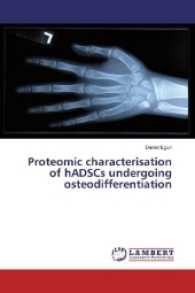- ホーム
- > 洋書
- > 英文書
- > Science / Mathematics
Full Description
The new age space value chain is a complex interconnected system with diverse actors, which involves cross-sector and cross-border collaborations. This book helps to enrich the knowledge of Artificial Intelligence (AI) across the value chain in the space-related domains. Advancements of AI and Machine Learning have impactfully supported the space sector transformation as it is shown in the book.
"This book embarks on a journey through the fascinating realm of AI in space, exploring its profound implications, emerging trends, and transformative potential."
Prof. Dr. Oliver Ullrich - Director Innovation Cluster Space and Aviaton (UZH Space Hub), University of Zurich, Switzerland
Aimed at space engineers, risk analysts, policy makers, technical experts and non-specialists, this book demonstrates insights into the implementation of AI in the space sector, alongside its limitations and use-case examples. It covers diverse AI-related topics applicable to space technologies or space big data such as AI-based technologies for improving Earth Observation big data, AI for space robotics exploration, AI for astrophysics, AI for emerging in-orbit servicing market, and AI for space tourism safety improvement.
Key Features:
Provides an interdisciplinary approach, with chapter contributions from expert teams working in the governmental or private space sectors, with valuable contributions from computer scientists and legal experts
Presents insights into AI implementation and how to unlock AI technologies in the field
Up-to-date with the latest developments and cutting-edge applications
Contents
SECTION I Introduction
Chapter 1: Introduction.
Olga Sokolova (Sirin Orbital Systems AG)
SECTION II Trends & Values
Chapter 2: Selected Trends in Artificial Intelligence for Space Applications.
Dario Izzo, Gabriele Meoni, Pablo Gomez, Dominik Dold , and Alexander Zoechbauer (European Space Agency ‒ ESA)
Chapter 3: Space Systems, Quantum Computers, Big Data and Sustainability.
Joseph N. Pelton (Chair of the Alliance for Collaboration in the Exploration of Space; Dean Emeritus, International Space University) and Scott Madry (University of North Carolina at Chapel Hill; Professor Emeritus, International Space University)
SECTION III Applications & Use-Cases
Chapter 4: Neuromorphic Computing and Sensing in Space.
Dario Izzo, Alexander Hadjiivanov, Dominik Dold, Gabriele Meoni , and Emmanuel Blazquez (European Space Agency ‒ ESA)
Chapter 5: Artificial Intelligence for Spacecraft Location Estimation based on Craters.
Keiki Takadama (University of Electro-Communications, Tokyo), Fumito Uwano (Okayama University), Yuka Waragai (University of Electro-Communications, Tokyo), Iko Nakari (University of Electro-Communications, Tokyo), Hiroyuki Kamata (Meiji University), Takayuki Ishida (Japan Aerospace Exploration Agency ‒ JAXA), Seisuke Fukuda (Institute of Space and Astronautical Science ‒ ISAS, JAXA), Shujiro Sawai (Institute of Space and Astronautical Science ‒ ISAS, JAXA), and Shinichiro Sakai (Institute of Space and Astronautical Science ‒ ISAS, JAXA)
Chapter 6: Artificial Intelligence for Space Weather Forecasting.
Enrico Camporeale (University of Colorado & NOAA Space Weather Prediction Center)
Chapter 7: Using Unsupervised ML to Make New Discoveries in Space Data.
Giovanni Lapenta (KU Leuven), Francesco Califano (University of Pisa), Romain Dupuis (Naval Group Belgium), Maria Elena Innocenti (Ruhr-Universität Bochum), and Giorgio Pedrazzi (Cineca)
SECTION IV Legal Perspectives
Chapter 8: Harnessing AI Technologies for Sustainable Space Missions: Legal Perspectives.
Steven Freeland (Western Sydney University) and AnneSophie Martin (Sapienza University of Rome)
SECTION V Market Perspectives
Chapter 9: Future-ready Space Missions Enabled by end-to-end AI Adoption.
Lorenzo Feruglio, Alessandro Benetton, Mattia Varile, Davide Vittori, Ilaria Bloise, Riccardo Maderna, Christian Cardenio, Paolo Madonia, Francesco Rossi, Federica Paganelli Azza, Pietro De Marchi, Luca Romanelli, Matteo Stoisa, Luca Manca, Gianluca Campagna, Armando La Rocca (AIKO S.r.l.)
SECTION VI Look Back from the Future
Chapter 10: Commercial Space Exploration Assisted by AI.
Anousheh Ansari and Jim Mainard (XPRIZE Foundation)








